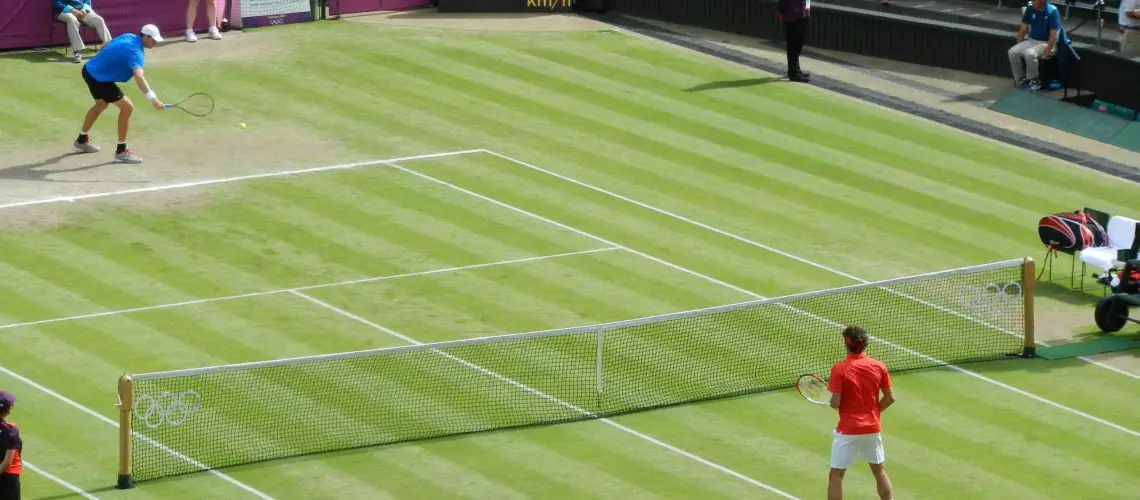We may earn money or products from the companies mentioned in this post.
Introduction

When it comes to playing tennis, having the right equipment can make all the difference in your performance on the court While choosing a high-quality racket is essential, personalizing and customizing it can take your game to the next level One way to achieve this is by painting your tennis racket
The Process of Painting a Tennis Racket
Painting a tennis racket involves several steps that require attention to detail and precision First, you need to gather all the necessary materials, including paint, primer, sandpaper, masking tape, and clear coat Next, you’ll need to prepare the racket by cleaning it thoroughly and sanding down any imperfections or previous paint layers Once prepped, you can apply primer as a base coat before adding your desired colors and designs
After allowing the paint to dry completely, it’s crucial to protect your masterpiece with a clear coat for durability This final step not only adds a glossy finish but also safeguards against scratches caused by intense gameplay
The Importance of Customization and Personalization
Tennis is not just about hitting balls back and forth; it’s an expression of individuality and style on the court By painting your tennis racket, you have the opportunity to create something truly unique that reflects your personality and sets you apart from other players
Customization allows you to showcase your creativity while giving yourself an extra boost of confidence when stepping onto the court Whether it’s incorporating your favorite colors or designing patterns that resonate with you personally, having a customized tennis racket adds an element of excitement every time you play
The Benefits of Having a Uniquely Designed Tennis Racket
Having a uniquely designed tennis racket offers more than just aesthetic appeal; there are practical benefits to consider as well Firstly, a customized racket is less likely to be mistaken for someone else’s during matches or practice sessions This reduces the chances of accidental swaps and ensures that you always have your trusted racket in hand
Additionally, a personalized tennis racket can enhance your focus and concentration on the court When you feel a connection to your equipment, it can help you stay mentally engaged and motivated throughout the game It becomes an extension of yourself, assisting in fluid swings and precise shots
Lastly, a uniquely designed racket can inspire conversation and camaraderie with fellow players Your eye-catching design may catch the attention of others and spark interesting discussions about style choices, techniques, or even potential collaborations in the future
Conclusion

Painting your tennis racket is not only a creative endeavor but also an opportunity to make your mark on the court The process allows for customization and personalization that can boost confidence, improve focus, and promote individuality while playing So why settle for a generic racket when you can create something extraordinary that reflects who you are as a player? Let your imagination run wild and unleash your true potential with a uniquely designed tennis racket
Preparing the tennis racket for painting

When it comes to giving your tennis racket a fresh new look, proper preparation is key Before you embark on this creative journey, it’s important to select the right paint materials that will not only withstand the rigors of the game but also showcase your personal style
Selection of suitable paint materials
In the world of paint, two popular options for racket customization are acrylic and enamel paints Acrylic paints offer versatility, quick drying time, and a wide range of vibrant colors On the other hand, enamel paints provide durability and a glossy finish
Deciding between spray paints or hand-painting techniques depends on your preference and skill level Spray paints allow for even coverage and smooth finishes with less effort, while hand-painting offers more control over intricate designs
Gathering necessary tools and supplies
Before diving into the painting process, make sure you have all the essential tools and supplies at hand Masking tape, painter’s tape, or stencil sheets will come in handy when designing patterns or logos on your racket
To create a flawless finish, sandpaper should be used to lightly roughen up the surface of the racket frame Primer helps with paint adhesion and ensures long-lasting results Brushes are essential for applying both primer and paint smoothly
Don’t forget to protect your hands by wearing gloves throughout this process
Preparing the surface of the racket for painting
Prior to painting your racket, it’s advisable to disassemble it if possible This prevents any accidental damage to strings or grip during the painting process Removing strings safely involves carefully releasing tension using a stringing machine or seeking professional assistance if needed
-
How to safely remove strings from your tennis racket frame?
-
How to protect grip during this process?
To safely remove strings, start by loosening the tension of each string gradually Use a stringing machine or a suitable tool to unwind and release the strings from the frame one by one
To protect the grip while painting, cover it securely with masking tape or painter’s tape This will prevent any accidental paint spills or smudges on the handle
Once the racket is disassembled and protected, proceed with cleaning and sanding its surface This step ensures better adhesion of paint and helps create a smooth canvas for your artistic vision
Painting Techniques and Design Considerations

Creating Design Templates
When it comes to customizing your racket, creating unique design templates can add a personal touch But how do you make custom stencils for your one-of-a-kind design? One option is to use stencil materials like acetate or cardboard and cut out your desired shapes using a craft knife Alternatively, you can also invest in stencil cutting machines that allow for more intricate designs with ease The possibilities are endless!
If you’re looking for inspiration, there are several popular patterns or designs that people commonly use on their rackets From sleek geometric patterns to vibrant abstract art or even team logos, the options are diverse Ultimately, choose a design that resonates with your style and personality
Applying Base Coats
Before adding any details, it’s essential to apply base coats to create a smooth canvas for your design The number of layers required depends on personal preference and the desired outcome Typically, applying two to three thin coats ensures good coverage without excessive buildup
Allow each layer of base coat to dry fully before applying the next one The ideal drying time between each coat varies depending on factors such as humidity and temperature but generally falls within 15-30 minutes Patience is key here; rushing through this step can lead to uneven surfaces or smudged designs
Adding Details Using Different Painting Techniques
Now comes the fun part – adding details using various painting techniques! One popular technique is brush painting, which allows for precise control over brush strokes and finer details To create smooth brush strokes without visible lines or texture, load your brush with paint and apply light pressure while maintaining steady hand movements
For intricate designs on rackets, it’s best to use brushes with fine bristles Look for brushes specifically designed for detailed work, such as liner brushes or spotter brushes These brushes offer better control and precision when working on smaller areas or intricate patterns
If you prefer a different approach, the spray painting technique can provide a sleek and uniform look When using spray cans, hold them approximately 6-8 inches away from your racket while spraying This distance ensures even coverage without excessive buildup or overspray
To prevent overspray and uneven coverage, take precautions such as masking off any areas you don’t want to paint and using smooth, continuous motions while spraying It’s also important to work in a well-ventilated area to avoid inhaling fumes
Finishing, Reassembling, and Maintaining the Painted Tennis Racket

Sealing Your Paint Job
After putting in all the hard work to paint your tennis racket, it’s crucial to protect your design with a clear coat or sealant But what type of clear coat should you choose? Opt for a high-quality polyurethane or epoxy-based sealant that is specifically designed for use on sports equipment These types of clear coats provide excellent durability and resistance to scratches, ensuring your design stays intact
When it comes to the number of layers you should apply, two coats are generally recommended Start with a thin initial coat to create a solid base, then follow up with a second slightly thicker coat for added protection Remember to allow each layer to dry completely before applying the next one
Reassembling the Tennis Racket After Painting
Once your paint job is sealed and dried, it’s time to reassemble your tennis racket However, this needs to be done carefully to avoid damaging the newly painted surface
When reattaching strings and grip, take extra precautions not to scrape or scratch the painted areas Use protective tape or cloth as a barrier between any tools and the racket’s surface Gently guide the strings back into place while being mindful of any potential contact with the paint
As for when you can start using your freshly painted racket on the court without risking damage, it’s best to wait at least 24 hours after applying the final sealant coat This allows ample time for curing and ensures that the paint has fully set before subjecting it to intense gameplay
Maintaining Your Custom-Painted Tennis Racket
To keep your custom-painted tennis racket looking its best, it’s essential to take proper care of it during storage and transportation
When storing your racket, use a protective cover or sleeve to shield it from potential impacts that could chip or scratch the paint Avoid stacking other objects on top of it and store it in a cool, dry place away from direct sunlight to prevent fading
During transportation, consider investing in a tennis bag with padded compartments specifically designed to protect rackets This will provide an extra layer of cushioning and prevent any accidental damage while on the move
Regular inspections are also important to identify signs of wear or damage on your painted racket Make it a habit to examine the surface for any chips, scratches, or fading If you notice any issues, promptly address them with touch-ups using matching paint colors and sealant
Useful Links

Tennis Racket Paintings for Sale
Racket Painting
How do you custom paint a tennis racket?
How To Paint A Tennis Court
spray painting tennis racket
How to upcycle a tennis racket | Toys and Games – Project 28
Custom Tennis Racquet
Tennis Racket Painting
Tennis Racket And Ball Paint By Numbers
Unstrung Customs (@unstrungcustoms) …
Tennis Racket And Ball Paint By Numbers
Tennis Racket And Ball Paint By Numbers
iPhone 7 Plus/8 Plus Paint Splash Tennis Ball Racket Case
Tennis Racket Painting by Daniel J Zyzniewski
Tennis Racket And Ball – 5D Diamond Painting
Tennis Racket Art | Life Series | Limited Edition Prints






